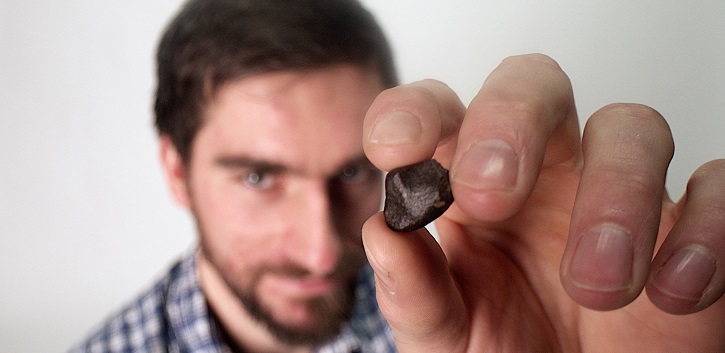Antarctica hunting ground for meteorites

UCC physics alum, Michael Coughlan, has perhaps solved the mystery that has puzzled planetary scientists and Antarctic explorers for decades.
A hidden reserve of iron-rich meteorites which could hold secrets to the formation of the Solar System may be hidden beneath the surface of the Antarctic ice sheet, according to Michael and a team from The University of Manchester. The paper, which he co-authored with the team was published in Nature Communications, suggests that these meteorites could be just 10-50cm from the surface making their retrieval tantalisingly possible.
Although meteorites fall evenly across the Earth’s surface, over two thirds of the total number of collected meteorites has been recovered in Antarctica, partly due to the contrast between the white Antarctic surface and the dark meteorites resting on top. However, it is primarily because of ice flow dynamics, which transport and concentrate meteorites buried in the ice for hundreds of years up to localised regions at the surface known as Meteorite Stranding Zones (MSZs). This has enabled highly fruitful meteorite collection missions from the MSZ surfaces since the 1970s, which have provided colossal insights for planetary scientists, and yielded many Lunar and Martian meteorite samples.
However, far fewer iron-rich meteorites are found in Antarctica than anywhere else on Earth. The reason behind their scarcity has remained a mystery until now, but Michael Coughlan and the team appear to have found the solution. They propose that the meteorites are missing as a result of the Sun’s rays penetrating the clear ice in MSZs and warming the iron-rich rocks more than non-metallic ones. Such warming melts the ice surrounding the meteorite, causing it to sink and offset all annual ice upwelling - this permanently traps the meteorites just below the surface.
The authors have combined laboratory experiments with mathematical models to show that typical thawing and freezing processes will cancel out the upward transportation of meteorites with high thermal conductivity (e.g. containing iron), allowing those with lower conductivities to emerge from the ice.
"Once we came up with the idea I tested it mathematically and in the lab, finding exactly what we had hoped,” says Michael. “It was captivating to observe a physical behaviour that hadn't been noted by science before, but more importantly to use it in solving a specific problem for scientists. It'll be exciting to see what they find under the ice in the near future".
According to Michael the result is important because it may explain why scientists have recovered puzzlingly few iron meteorites, which are so valuable, from Antarctica, where most of the world's finds are recovered; better still, it offers a way of finding them, and gives us a greater insight into the processes that effect Antarctic meteorites. “Every meteorite recovered teaches us more about the solar system,” he says “and iron meteorites are particularly important as they come from the cores of planets. They can tell us about how planets like ours formed, about early planets that no longer exist, and in reality, are small pieces of stardust."
To read more see Nature Communications article http://www.nature.com/ncomms/2016/160216/ncomms10679/abs/ncomms10679.html
